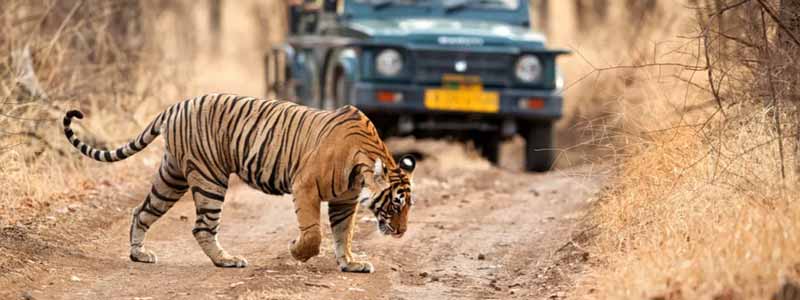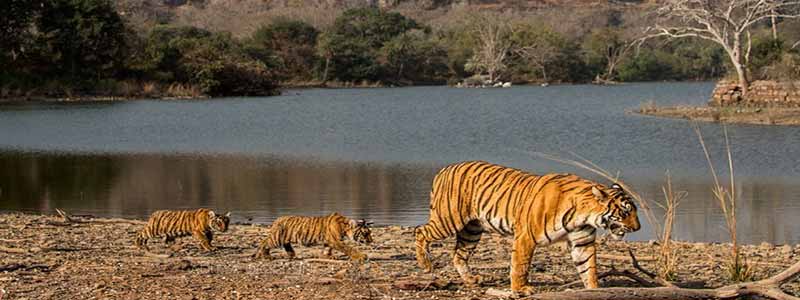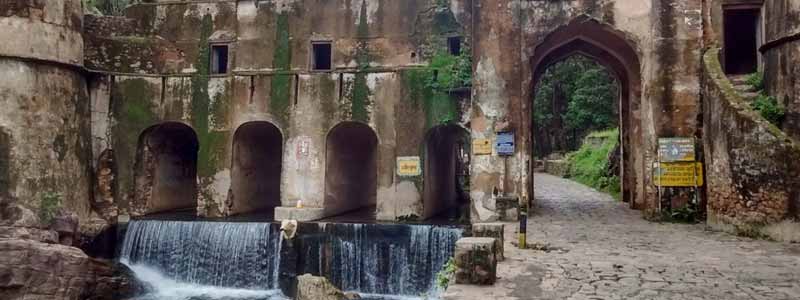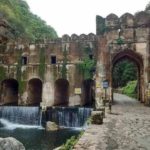Ranthambore Travel Guide is a vast wildlife reserve near the town of Sawai Madhopur in Rajasthan, northern India. It is a former royal hunting ground and home to tigers, leopards and marsh crocodiles. Its landmarks include the imposing 10th-century Ranthambore Fort, on a hilltop, and the Ganesh Mandir temple. Also in the park, Padam Talao Lake is known for its abundance of water lilies.
The Ranthambore National Park is where you should land up if you want to spot the king of the jungle. The park covers 1334 sq.km. of thick jungle, winding dirt roads, and lakes, making a safari here a once in a lifetime experience.
Ranthambore National Park is perfect for animal lovers. Besides glimpses of the tiger in its natural habitat, the park is home to nilgai, wolf, sambhar, bear, hyena, jackal, caracal, and leopard. Ranthambore Travel Guide The park is also a birdwatcher’s paradise with the nightjar, greylag goose, great crested grebe, and a number of migratory birds that inhabit the tall trees and bushes. The best time to visit the park is between October and April.
Ranthambore National Park’s unparalleled topography is a welcome change. The wild jungle is spread out over deep valleys and bluffs, spotted with rivers and lakes, making it a nature lover’s dream. While the animals are the main draw, there are a number of other attractions within the park that should be explored Ranthambore Travel Guide.

Ranthambore National Park Safari Timings
The safari in Ranthambore National Park starts with the sunrise in the morning, and ends with the sunset in the evening, with both the morning and evening safari timings being 3:30 hours. Throughout the year, the time of safari varies according to the weather, so for the present time, please check the official website of Ranthambore Travel Guide once.
In Rajasthan, the monsoon falls in July, so the safari is closed in the garden from July 1 to October 1, although some parts of the buffer zone remain open. For your convenience, I am sharing the time table of Ranthambore National Park.
| S.No. | Month | Morning Trip | Evening Trip |
| 01 | 1st Oct to 31st Oct | 6:30 AM to 10:00 AM | 2:30 PM to 6:00 PM |
| 02 | 1st Nov to 31st Jan | 7:00 AM to 10:30 AM | 2:00 PM to 5:30 PM |
| 03 | 1st Feb to 31st March | 6:30 AM to 10:00 AM | 2:30 PM to 6:00 PM |
| 04 | 1st April to 15th May | 6:00 AM to 09:30 AM | 3:00 PM to 6:30 PM |
| 05 | 15th May to 30th June | 6:00 AM to 09:30 AM | 3:30 PM to 7:00 PM |

Ranthambore Tiger Reserve Safari
Two types of safari vehicles are available by Rajasthan Forest Department at Ranthambore Tiger Reserve. 4 wheel drive gipsy and open roof bus called Canter. Limited vehicles are allowed by the Forest Department to enter the park.
The maximum limit for entry of vehicles in this park is 40 at a time. Out of which 20 canters with 17 Gypsies and 3 VIP Gypsies are allowed entry. To increase employment among the residents, the forest department takes all these vehicles on tender, Ranthambore Travel Guide the ownership of these vehicles remains by the residents.
If a vehicle is not attached to the forest department, then that vehicle is not allowed to enter the park. By the way, there is a possibility of getting a Safari ticket even at the booking window. But in terms of security, if you book a safari in advance before coming here, it would be better.
Gypsy Safari
Gipsies are the most popular option to view the herds of wildlife in this national park or to see the beautiful natural scenery. The Gypsy can seat 6 people at a time, due to this the vehicle provides a great opportunity for your family or to personally see this garden. If you want to book a gipsy, you should book a safari for 3 months in advance.
Canter Safari
A canter is an open roof bus in which 20 people can ride at a time. Because of this, there can be no better option for a large group to enjoy this national park. If you are with your friends, or if you are on a family trip, then walking in this garden in the canter can be a memorable experience.
There is a possibility that if you have not done advance safari booking then you can find the canter available at the booking window, but in my suggestion, you should go to this garden by booking an advance safari.

Places to visit in Ranthambore
Things to see Ranthambore It is quite clear that it is not easy to describe this land in few lines with simple words. As every next visitor who visits Ranthambore has his/her own definition about the place, one finds it the most adventurous trip ever, one finds peace in nature. One is happy with the overall aura of the place and one can never forget the beautiful landscape views the place has to offer!
Ranthambore Travel Guide Let’s see how well are you able to define this amazing land resting in the royal state of Rajasthan.
Ranthambore Fort
This huge fort built around the 10th century is one of the largest forts in Rajasthan. The most special thing that I felt about this fort is that this fort is not visible to you until you reach this fort, and when you reach the highest part of this fort, you will find the Aravali The vast and naturally rich entire forest spread across the ranges is visible.
Since its construction, this fort has seen many wars, almost every Rajput ruler and Mughal invader of that time attacked this fort and tried to win over it. But the rule of 19 years of Rana Hammir Dev is still the identity of this fort. In the 17th century, the power of this fort came into the hands of the Rajput kings of Jaipur. After that, the jungles surrounding this naturally rich fort started to be used by the Kings of Jaipur for hunting and entertainment.
In 2013, this fort was included in the UNESCO World Heritage Site. Located in the central part of Ranthambore National Park, this fort is identified with this national park. Most of the tourists coming here come to see the Ranthambore National Park located here instead of this fort, after that if they get time then they like to see this fort.
Therefore, I first wrote a separate blog on Ranthambore Tour Packages so that every tourist who comes here can understand the history and beauty of this huge fort and can connect with this fort. In my suggestion, whenever you make up your mind to visit Ranthambore Travel Guide, then you must write the name of Ranthambore fort in your bucket list.
Ranthambore National Park
Surrounded by the Aravalli ranges, this national park (forest) is naturally quite rich and beautiful. A visit to this park becomes forever unforgettable for every tourist visiting this national park full of wildlife and vegetation. Apart from the tiger, you can see a leopard, sloth bear, deer, chital, Indian striped hyena and a lot of migratory birds in this national park.
In this forest enriched with lakes and ponds, you get to see the second-largest banyan tree in India. This place enjoyed hunting here for years before becoming a national park. After India became independent, poaching has been practised at this magnificent place for years, before Project Tiger started in 1973 there were only 1000 tigers left in India.
While being part of Project Tiger in 1973, there were only 37 tigers left in Ranthambore Travel Guide. Ranthambore was declared a national park in 1980, after that, due to the hard work of the forest workers and officials, at present, there are more than 70 tigers in this national park.
There is every possibility of increasing the number of tigers in this national park in the future, at present the situation is such that millions of native and foreign tourists visit this place in Ranthambore National Park every year.
Padam Talao
Padam Palao is the largest lake inside Ranthambore National Park. At the edge of this lake, you can see the very famous Jogi Mahal. The lily flowers which are the reason for the lake to get its name as Padam Talao will be seen in abundance during the season. The surrounding of the lake is beautified with thick green forests.Along with it, the relishing sights of umpteen numbers of birds coming to the lake will attract everyone’s eyes and heart.
In the early morning and evening, you can also see the wild animals coming to drink water from the lake. The National Park’s whole beauty is enhanced by the presence of this picturesque lake filled with lilies at times. The rare sights of Chinkara are possible at the very edge if this particular lake, Ranthambore Travel Guide.
Malik Talao
One of the three lakes in Ranthambore National park, Malik Talo, comparatively the smaller is considered to be a must visit among the places to visit in Ranthambore. Nestled amidst the huge green forest, it acts as a haven for thousands of migratory birds as well as Marsh crocodiles.Whenever you visit Ranthambore National Park, never forget to visit this particular lake which opens to the visitors at two different timings either in the morning or in the evening.
You might get to see some variety types of birds as well that come to catch their food from the lake. The view of the surroundings will nourish your eyes undoubtedly and it will be obviously a picturesque nature everywhere. Ranthambore Travel Guide Also if luck favors, you will spot the wild animals coming to drink water from the lake at times.
The three-eyed Ganesh temple
Like every town or tourist destination in India has, Ranthambore also has a popular temple that sees thousands of believers every year on its doorstep. It is the three-eyed Ganesh temple and is a must-visit even if you are not one of the spiritual experiences. It is an ancient temple inside the fort and seeing something so grand is a treat in itself.
For those who are coming in for the spiritual experience, they will love the five aartis that happen every day at the temple. No matter what, you can’t skip this out of you Ranthambore Travel Guide list for sure. The architecture and the built structure will surprise you on its own for it to be an experience in its own. Even the vibes around the temple are worth catching onto.
Raj Bagh Talao
Raj Bagh Talao is comparatively the most beautiful among the three lakes within Ranthambore National Park. The ruins at the extreme edges of the lake add more beauty to it. Since it is located amidst the lush green forests reserve, the wildlife animals are the frequent visitors to the lakes for drinking water. The sambhar deer is a regular visitor who eats the grass present on the floor of the lake.
Rare types of birds, animals, and species come around the vicinity of the lake in the morning and evening when the weather seems to be cooler. It is a tiger spotting area as well along with other rare animals in the park come since the area has a wide range of forest area and water resources Ranthambore Travel Guide.
Rajiv Gandhi Regional Museum of Natural History
The Rajiv Gandhi National Museum or The Regional Museum of Natural History, Sawai Madhopur is India’s fourth regional museum of natural history and it is termed as one of the best places to visit in Ranthambore. The museum has the exhibits of rare plants, animals and, geology of the Western part of India. The main aim of this museum is to create awareness among the public about the importance of preserving the flora and fauna which are very rare in the surrounding.It helps to understand the diversity of earth as well.
There are three floors in the museum but the visitors have access only to the ground floor where ‘Biodiversity of Rajasthan or Forests and Wildlife of Rajasthan’ are mainly exhibited. The facsimile of animals such as chinkara (gazelle), leopard, lion, and tiger are the main attractions along with the collection of village dioramas of the Bishnoi community and Rajasthan rural area.Location: Ramsinghpura, Sawai Madhopur, Ranthambore Travel Guide, Rajasthan.
Best Time to Visit Ranthambore
Ranthambore is known for its Tiger reserve, and the park opens in the month October and closes in the month of June, and the chances of spotting a tiger is highest in the Summer season, that probably is the best time to visit Ranthambore.
How to Reach Ranthambore
By Air – Jaipur is the nearest airport to Ranthambore situates at a distance of 180 Kms.
By Road – Ranthambore is well connected to all the major cities of Rajasthan via road, so one can definitely opt for a personal conveyance or a bus service to reach this spot.
By Rail – Sawai Mahopur is the nearest railway station to Ranthambore Travel Guide, which is well connected with a lot of major cities like Delhi, Jaipur etc.








